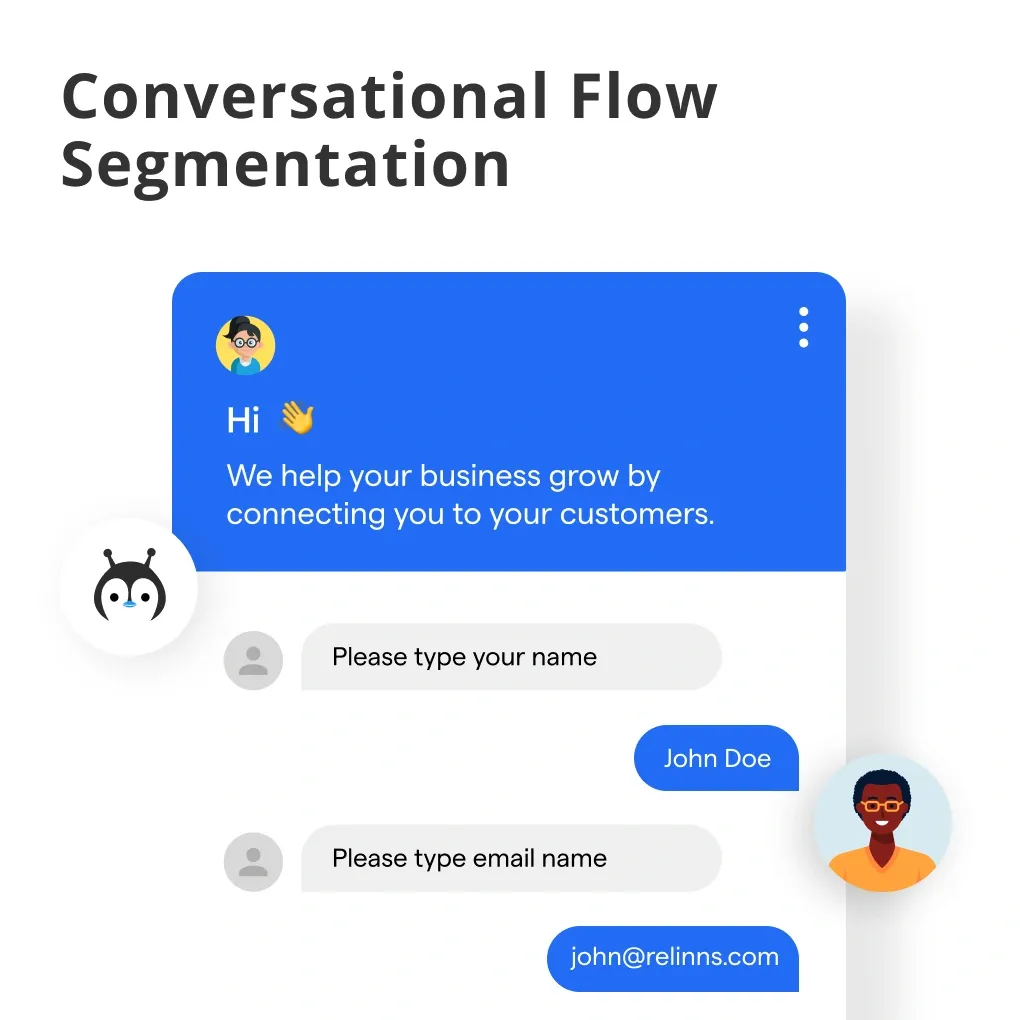What is Conversational Flow Segmentation?
Conversational Flow Segmentation is the process of breaking down a conversation into smaller, manageable segments to improve understanding and context in chatbots and AI-powered communication systems.
It helps maintain a structured dialogue, manage user expectations, and ensure smooth transitions between different conversation topics.
By effectively segmenting a conversation, chatbots can provide more natural and engaging interactions, making users feel like they're having a genuine conversation with a human rather than an AI system.
Overall, Conversational Flow Segmentation plays a crucial role in enhancing the user experience in various applications, from customer support to virtual personal assistants.
Why Implement Conversational Flow Segmentation?
Enhanced User Experience
First and foremost, conversational flow segmentation is all about improving the user experience. Imagine chatting with a support agent or chatbot that understands your needs and preferences. No more robotic or irrelevant responses! Instead, you'll be greeted with personalized, engaging, and genuinely helpful interactions. It's like a warm hug from your favorite aunt, but in the form of a conversation.
Streamlined Customer Support
Conversational flow segmentation helps streamline customer support by:
- Reducing response times
- Ensuring customers are directed to the most appropriate support channel or agent
- Providing support agents with the necessary context to offer more accurate assistance
Increased Sales and Conversions
Last but certainly not least, conversational flow segmentation can work wonders for your sales and conversions. By delivering tailored, personalized experiences, customers are more likely to:
- Feel valued and appreciated
- Engage with your brand and its offerings
- Make a purchase or take a desired action
So, not only does conversational flow segmentation make customers happier, but it can also boost your bottom line. Cha-ching!
Who can Benefit from Conversational Flow Segmentation?
Customer Service Teams
By implementing conversational flow segmentation, these teams can:
- Resolve issues more efficiently
- Deliver personalized, delightful interactions
- Improve customer satisfaction and loyalty
So, if you're a customer service superstar, get ready for some serious high-fives from your happy customers!
Sales and Marketing Professionals
Conversational flow segmentation can help them:
- Nurture leads more effectively
- Tailor marketing messages to different audience segments
- Improve conversion rates and boost revenue
With conversational flow segmentation in their toolkit, sales and marketing pros can watch those deals flow in like a well-choreographed dance routine.
Chatbot Developers and AI Specialists

They build and maintain the digital assistants that make our lives easier. Conversational flow segmentation can help them:
- Design more engaging and helpful chatbot experiences
- Continuously optimize chatbot performance
- Keep up with evolving customer preferences and expectations
So, if you're a chatbot developer or AI specialist, prepare to bask in the glory of your ever-improving conversational creations!
When to Use Conversational Flow Segmentation?
Stages of Customer Interaction
Conversational flow segmentation can be used during various stages of customer interaction, such as:
- First contact: Make a great first impression by providing personalized greetings and relevant information.
- Problem-solving: Quickly identify customer concerns and match them with the right solutions.
- Sales and upselling: Recommend products or services based on customer preferences and needs.
- Post-sales support: Provide ongoing assistance and nurture long-term relationships.
Identifying Opportunities for Improvement
So, how does one know when to harness the power of conversational flow segmentation? It's all about keeping an eye out for opportunities to improve and enhance customer experiences. Here are some tell-tale signs that it's time to dive into conversational flow segmentation:
- High volume of repetitive queries: Streamline responses and provide more accurate assistance.
- Low customer satisfaction: Improve communication and tailor interactions to customer preferences.
- Ineffective sales and marketing efforts: Personalize messages to better resonate with different audience segments.
Where is Conversational Flow Segmentation Applied?
Customer Support Chatbots
Conversational Flow Segmentation is applied in customer support chatbots to create structured and context-aware interactions, improving the user experience and increasing the chatbot's efficiency in resolving customer inquiries.
Virtual Personal Assistants
Virtual Personal Assistants, like Siri, Alexa, and Google Assistant, use Conversational Flow Segmentation to maintain context and provide relevant responses, making interactions with users more natural and engaging.
Sales and Marketing Chatbots
Segmentation is used in sales and marketing chatbots to guide users through the purchasing process, ensuring smooth transitions between conversation topics, and providing personalized product recommendations based on user preferences.
Healthcare Chatbots
Healthcare chatbots benefit from Conversational Flow Segmentation by maintaining context during patient interactions and providing accurate, relevant information based on the user's medical history, symptoms, and concerns.
E-Learning and Tutoring Chatbots
E-learning and tutoring chatbots use Conversational Flow Segmentation to create structured and context-aware learning experiences, guiding users through educational content and providing personalized feedback based on their progress and performance.
How to Implement Conversational Flow Segmentation?
Step 1
Analyzing Existing Conversations
The first step in implementing conversational flow segmentation is to analyze existing conversations. This involves:
- Reviewing chat logs and customer interactions
- Identifying common themes, topics, and concerns
- Recognizing patterns in customer behavior and preferences
By studying existing conversations, businesses can gain valuable insights into how to better segment and tailor future interactions.
Step 2
Defining Conversation Paths and Goals
Next, it's time to define conversation paths and goals. This means:
- Mapping out possible conversation flows
- Identifying key decision points and user intents
- Setting specific goals for each conversation segment
By defining conversation paths and goals, businesses can create more purposeful and focused interactions that cater to customers' unique needs and preferences.
Step 3
Establishing Segmentation Criteria
Finally, it's time to establish segmentation criteria. This involves:
- Determining the factors that will be used to segment conversations (e.g., topic, audience, context)
- Developing rules and algorithms to categorize and direct conversations
- Continuously refining and updating segmentation criteria based on customer feedback and performance metrics
Types of Conversational Flow Segmentation
Topic-Based Segmentation
First up, we have topic-based segmentation. As the name suggests, this approach divides conversations based on the topic or subject matter. For example:
- Product Inquiries
- Billing issues
- Technical support
By segmenting conversations by topic, businesses can ensure that customers receive the most relevant and helpful information, making their interactions smoother and more satisfying.
Audience-Based Segmentation
Next on the list is audience-based segmentation. This approach involves segmenting conversations based on the characteristics and preferences of the audience. For instance:
- New vs. returning customers
- Age, gender, or location
- Specific interests or preferences
Audience-based segmentation allows businesses to tailor their communication style and content to better connect with customer segments, making interactions more personal and engaging.
Context-Based Segmentation
Last but not least, we have context-based segmentation. This approach takes into account the context in which the conversation is taking place, such as:
- Time of day or day of the week
- Customer's location or device
- Previous interactions and history
By considering the context, businesses can adapt their conversations to suit the customer's situation better, making them feel more understood and cared for.
Best Practices for Conversational Flow Segmentation
Greetings, my conversational virtuosos! Today, we'll explore the best practices for conversational flow segmentation, ensuring that your customer interactions are nothing short of spectacular. So, grab your favorite beverage, get comfy, and let's dive in!
Balancing Automation and Human Touch
First up, we have the delicate dance of balancing automation and human touch. While automation can streamline and optimize customer interactions, it's crucial to remember that we're still dealing with humans who crave genuine connection. Here are some tips for striking the perfect balance:
- Use automation for routine and repetitive tasks, like answering FAQs or gathering basic information.
- Escalate complex issues or emotionally charged situations to human agents, who can provide empathy and nuanced problem-solving.
- Personalize automated responses with the customer's name, history, or preferences to make them feel valued and understood.
Balancing automation and human touch'll create a harmonious blend of efficiency and warmth in your customer interactions.
Continuously Refining and Updating Segments
Next up, we have the art of continuously refining and updating segments. Conversational flow segmentation is not a one-and-done affair—it requires ongoing attention and improvement. Here's how to keep your segments fresh and effective:
- Regularly analyze conversation data to identify new trends, patterns, or customer needs.
- Update segmentation criteria and rules to reflect evolving customer preferences and expectations.
- Test and iterate on different conversation flows, learning from both successes and failures.
By staying vigilant and adaptive, you'll ensure that your conversational flow segmentation remains relevant and impactful.
Measuring Success and Adapting Strategies
Lastly, we have the essential practice of measuring success and adapting strategies. To gauge the effectiveness of your conversational flow segmentation, you'll need to track various metrics and make data-driven adjustments. Here are some tips for measuring and refining your strategies:
- Establish clear KPIs (Key Performance Indicators), such as customer satisfaction, response time, or conversion rate.
- Monitor and analyze these metrics to identify areas of strength and weakness.
- Adjust your conversational flows, segmentation criteria, or automation rules based on your findings, and continually iterate to improve performance.
By measuring success and adapting your strategies, you'll ensure that your conversational flow segmentation efforts deliver consistent, exceptional results.
Frequently Asked Questions
What is Conversational Flow Segmentation?
Conversational Flow Segmentation divides a conversation into smaller, manageable segments to improve understanding, context, and overall user experience in chatbots and AI-powered communication systems.
Why is Conversational Flow Segmentation important?
Segmentation helps maintain context, manage user expectations, and ensure smooth transitions between conversation topics, resulting in more natural and engaging interactions with chatbots and AI systems.
How does Conversational Flow Segmentation work?
Conversational Flow Segmentation typically involves identifying user intents, extracting relevant information, and maintaining context across multiple conversation turns to create a coherent, structured dialogue.
Can Conversational Flow Segmentation improve chatbot performance?
Effective segmentation can enhance chatbot performance by enabling better context management, more accurate intent recognition, and smoother transitions between conversation topics.
Are there tools for implementing Conversational Flow Segmentation?
Many chatbot development platforms and natural language processing (NLP) libraries provide tools and techniques for implementing conversational flow segmentation, such as BotPenguin, Rasa, and Microsoft Bot Framework.

